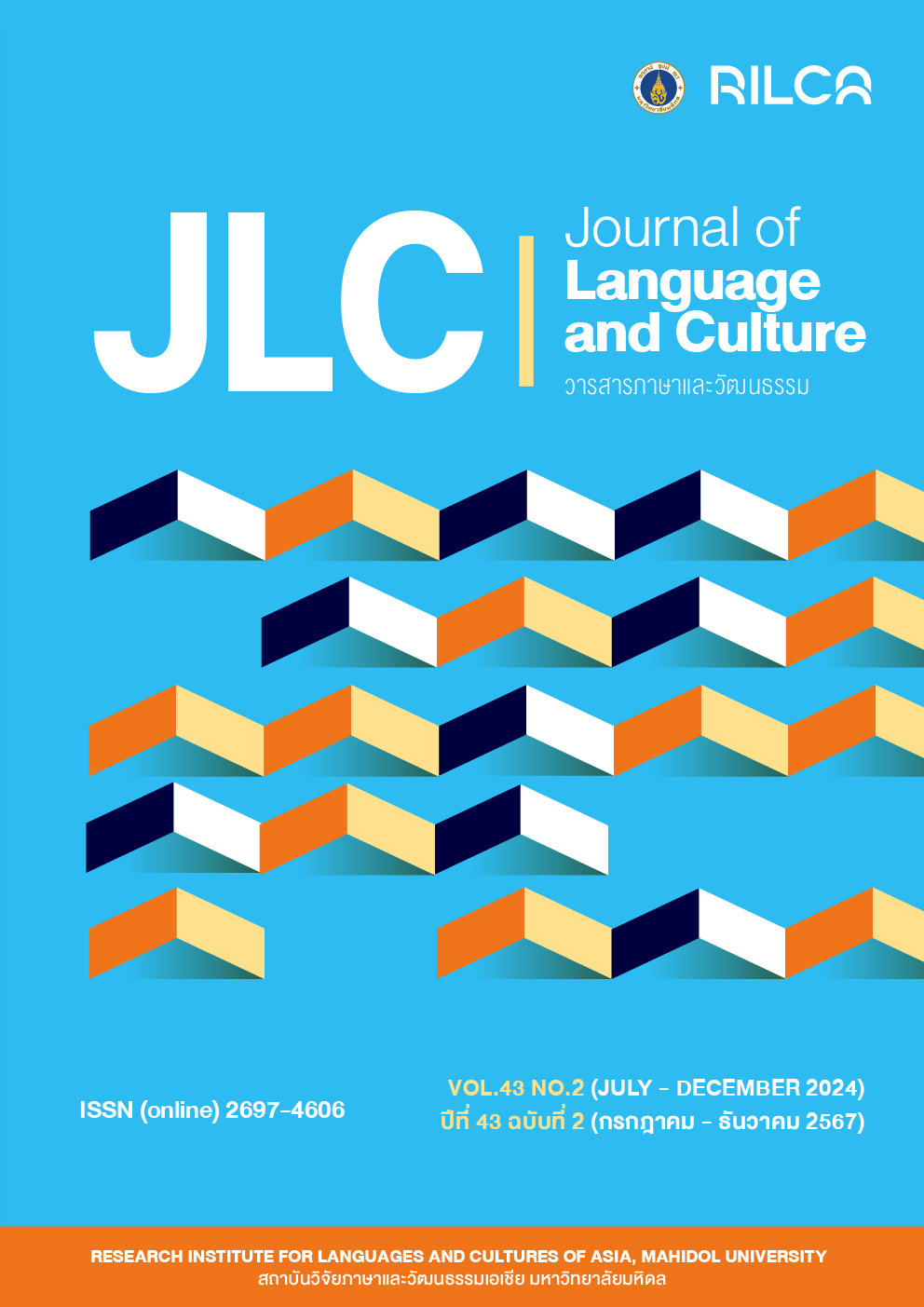Unveiling Cultural Dynamics: A Survey on China’s CET-4 Passage Translation in the Context of World Englishes
Main Article Content
Abstract
In today’s interconnected world, the diverse manifestations of English varieties have garnered significant attention due to their relevance in the realm of World Englishes. As English continues to interact with various cultures, it gives rise to distinct linguistic variations. In China’s higher education system, significant reforms have been implemented in the evaluation of the College English Test (CET). Notably, the Chinese-English passage translation section underwent noteworthy modifications, incorporating profound Chinese cultural attributes. Against this backdrop, this thesis centers on CET-4 as a starting point to investigate students’ proficiency in Chinese culture, cultural translation competence, and intercultural communication aptitude. This study employed a comprehensive questionnaire and quiz among 164 randomly selected college students from various grades at Guangxi University of Foreign Languages, revealing the significant impact of Chinese culture aphasia on academic performance in the CET translation section. To promote English localization in China, the paper suggests reinforcing the integration and dissemination of Chinese culture within World Englishes, fostering international and cultural perspectives, and enhancing intercultural communication skills for college teachers and students. Simultaneously, these efforts will amplify the distinctiveness of China English, gaining global recognition. This research presents empirical evidence on the influence of cultural elements on language performance, contributing to the growing literature on the interplay between language, culture, and communication in World Englishes. The findings emphasize the importance of promoting cultural awareness in language education for effective intercultural communication in a diverse world.
Article Details

This work is licensed under a Creative Commons Attribution 4.0 International License.
The articles featured in the Journal of Language and Culture (JLC) constitute academic works representing the viewpoints of the respective author(s). It is crucial to note that these opinions do not necessarily reflect those of the Editorial Board.
All articles published in JLC are released under the Creative Commons Attribution 4.0 International License (CC BY 4.0). This license grants permission for unrestricted use, distribution, and reproduction in any medium, provided proper credit is given to the original author(s) and the source.
References
Cong, C. (2000, October 19). Chinese culture aphasia: The shortcomings of foreign language teaching in China. Guangming Daily, C1.
Crystal, D. (1988). The English language. Cambridge University Press.
Du, W. (2016). Research on the present situation of Chinese cultural English expression ability of non-English majors. Enterprise Guide, 5, 87-88. https://doi.org/10.19354/j.cnki.42-1616/f.2016.05.061
Guan, M., & Su, X. (2019). The phenomenon and countermeasures of “Chinese cultural aphasia” of non-English majors. Journal of Inner Mongolia University of Finance and Economics, 1, 135-137. https://doi.org/10.13895/j.cnki.jimufe.2019.01.034
Honna, N. (1999). English as a language for international communication: An Asian perspective. Foreign Language Teaching and Research Press.
Hua, Y. (2010). Reflection on foreign language and culture teaching from the perspective of “cultural aphasia” in China. Journal of Gansu Lianhe University (Social Science Edition), 26(3), 108-111. https://doi.org/10.13805/j.cnki.2095-7009.2010.03.023
Jenkins, J. (2000). The phonology of English as an international language. Oxford University Press.
Jiao, B. (2010). World English theory and China English outlook. Journal of Hebei University of Technology (Social Science Edition), 1, 123-129.
Kachru, B. B. (1985). English in the world: Teaching and learning the language and literatures. Cambridge University Press.
Lee, W. (1981). Editorial. World Language English, 1, 1-2.
Liu, X. (2014). Cultural heritage and innovation: The fundamental mission of college English teaching. University Education Science, 5(4), 17-21.
National College English Testing Committee. (n.d.). Reform plan for the College English Test (CET-4 and CET-6). https://cet.neea.edu.cn/res/Home/1704/55b02330ac17274664f06d9d3db8249d.pdf
Nida, E. A. (2001a). Beyond the sentence: Discourse and the structure of text. Stanford University Press.
Nida, E. A. (2001b). Language and culture: Contexts in translation. Shanghai Foreign Language Education Press.
Trudgill, P., & Hannah, J. (2000). International English. Foreign Language Teaching and Research Press.
Wen, Q., & Yu, X. (2003). Internationalization and localization of English. Foreign Language Teaching Abroad, 3, 6-11.
Wu, Y. (2020). Research on the phenomenon of “Chinese culture aphasia” among the college students in China—Based on a survey study of Heilongjiang Bayi Agricultural University. Journal of Language Teaching and Research, 11(2), 301-308. https://doi.org/10.17507/jltr.1102.20
Xi, J. (2014, September 24). Speech at the opening ceremony of the International Conference in Honor of the 2565th Anniversary of Confucius & Fifth Congress of the International Confucian Association. Xinhua Net. http://news.xinhuanet.com/politics/2014-09/24/c_1112608569.htm
Yan, Y., & He, S. (2010). College English from the perspective of “China English”. Theory Monthly, 12, 106-108. https://doi.org/10.14180/j.cnki.1004-0544.2010.12.023
Zhang, Q. (2021). Impacts of World Englishes on local standardized language proficiency testing in the Expanding Circle: A study on the College English Test (CET) in China. English Today, 38(4), 254–270. https://doi.org/10.1017/S0266078421000158
Zhang, Y., & Zhu, Y. (2021). Research on the influence of “cultural aphasia” on the translation of College English Band 4 and 6. Industry and Technology Forum, 3, 192-193.


